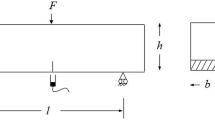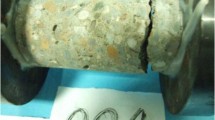Abstract
Experiments on concrete have shown a considerable increase of apparent tensile strength with increasing loading rate. This phenomenon can be attributed to various mechanisms such as kinetics of energy barriers and inertia effects in the vicinity of a running crack. After a general introduction into the behaviour of concrete under a uniaxial tensile stress, a model is presented which accounts for flaws in concrete and the inertia effects around a crack at high loading rates. It turns out that the quite crude model predicts rather accurately the relation between apparent strength and loading rate, the influence of concrete quality on this relation, and the relation between crack propagation velocity and loading rate.
Similar content being viewed by others
References
R. John and S.P. Shah, Mixed mode fracture of concrete subjected to impact loading, NSF-ACBM Report, Northwestern University, Evanston, January 1989, 1–18.
A. Hillerborg, International Journal of Cement Composites 2 (1980) 177–184.
D.A. Hordijk and H.W. Reinhardt, in Brittle Matrix Composites 2, A.M. Brandt and I.H. Marshall (eds.), Elsevier Applied Science Series, London (1988) 486–495.
H.A. Kormeling and H.W. Reinhardt, International Journal of Cement Composites and Lightweight Concrete 9 (1987) 197–204.
A.S. Krausz and K. Krausz, Fracture Kinetics of Crack Growth, Kluwer Academic Publishers, Dordrecht (1988).
H. Mihashi and F.H. Wittmann, Heron 25 (1980) 1–54.
M.E. Kipp, D.E. Grady and E.P. Chen, International Journal of Fracture 17 (1980) 471–478.
S.P. Shah and R. John, in Fracture Toughness and Fracture Energy of Concrete, F.H. Wittmann (ed.), Elsevier, Amsterdam (1986) 453–465.
D. Muria Vila and P. Hamelin, in Proceedings 1st RILEM Congress 2, Chapman & Hall, London (1987) 725–732.
M. Curbach, Festigkeitssteigerung von Beton bei hohen Belastungsgeschwindigkeiten, Dr.-Ing. dissertation, Karlsruhe, Germany, 1987.
J. Weerheijm, Schematisation of the fracture process in concrete under compressive and tensile loading, Research report TNO-PML No. 1987-16, Delft (1987) in Dutch.
L.B. Freund, Journal of the Mechanics and Physics of Solids 21 (1973) 47–61.
K.B. Broberg, Arkiv fur Fysik 18 (1960) 159–192.
C. Atkinson and J.D. Eshelby, International Journal of Fracture Mechanics 4 (1968) 3–8.
J.D. Achenbach and L.M. Brock, in Dynamic Crack Propagation, G.H. Sih (ed.), Noordhoff, Leyden (1972).
H. Nozaki et al., International Journal of Solids and Structures 22 (1986) 1137–1147.
N.F. Mott, Engineering 165 (1948) 16–18.
J.P. Berry, Journal of the Mechanics and Physics of Solids 8 (1960) 194–206.
J. Weerheijm, Properties of Concrete Under Dynamic Loading 3. Fracture Model for Brittle Materials, PML 1990–9, Rijswijk (1990).
I.N. Sneddon, in Mechanics of Fracture 1. Methods of Analysis and Solutions of Crack Problems, G.C. Sih (ed.), Noordhoff, Leyden (1973).
E.P. Chen, in Proceedings Symposium on Cement-Based Composites: Strain Rate Effects on Fracture, Materials Research Society Symposium Proceedings 64 (1986) 63–77.
R. John and S.P. Shah, A fracture mechanics model to predict the rate sensitivity of mode I fracture of concrete, Northwestern University, Evanston, November 1986.
A.J. Zielinski, Fracture of Concrete and Mortar Under Uniaxial Impact Tensile Loading, Delft University Press, Delft (1982).
J. Takeda and H. Tachikawa, in Proceedings International Conference on Mechanical Behaviour of Materials, Kyoto IV (1971) 267–277.
J. Weerheijm and W. Karthaus, in Proceedings Symposium on The Interaction of Non-Nuclear Munitions with Structures, Panama City Beach (1985).
J. Weerheijm and H.W. Reinhardt, in First International Conference on Structures Under Shock and Impact, Cambridge, Massachusetts (1989).
Author information
Authors and Affiliations
Rights and permissions
About this article
Cite this article
Reinhardt, H.W., Weerheijm, J. Tensile fracture of concrete at high loading rates taking account of inertia and crack velocity effects. Int J Fract 51, 31–42 (1991). https://doi.org/10.1007/BF00020851
Received:
Accepted:
Issue Date:
DOI: https://doi.org/10.1007/BF00020851




